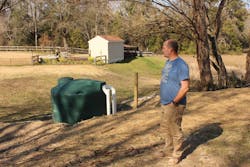Pat Cleary is vice president of Stevens Maintenance. Cleary can be reached at [email protected].
Down around the brackish waters of the Commonwealth of Virginia where the Chesapeake Bay merges into the Atlantic Ocean, there is a sense of water, water everywhere. This region, historically known as Tidewater, supports a large commercial, industrial and military presence.
Seated in a camping chair in his backyard up Knotts Creek, a tributary to the Nansemond River, Dave Joyner is content to describe his view of water use stewardship, one drop at a time. The environmental scientist is in the middle of a residential cost-sharing project with the Virginia Association of Soil & Water Conservation Districts, installing a rainwater harvesting system on his property, mere yards from a marshy cove on Knotts Creek. The district uses the program to encourage development of systems in primarily urban, residential settings. Joyner’s property fits the bill, an older home in a brick rancher subdivision built in the 1970s. Even here, he talks about everything from PVC piping size to "treatment train" storm water management strategies. His system, when completed, as an example, will also collect the condensation from his heat pump system.
“People are often surprised by how much water comes off a roof,” Joyner said. The calculations are that about 1,000 square feet of impervious surface, during a 1-inch rainfall, produces 600 gallons of water, he said.
“I like the idea of turning a potential problem into a solution, looking at things differently,” Joyner said.
Efforts at Home
For water resource professionals, a more comprehensive view has come out of the rain-barrel, so to speak, for the past decade. This thinking brings homeowner ideas of putting non-chlorinated water on a garden in line with how a residential system fits into a broadening watershed management understanding.
Better integration of water management runs the spectrum in an era when many water resource managers and educators are pursuing public acceptance of conservation techniques closer to home. Grass roots efforts trickle up to watershed management, keeping water in place for as long as possible.
The conservation district has participated in 33 rainwater cost-sharing projects since 2016. Other BMP management opportunities mirror what commonwealth officials have been pushing for years in their effort to protect the Chesapeake Bay, the largest bay system in the country.
“We really don’t market the program here at the state level,” said Maura Christian, assistant coordinator for the district. The member districts serve as the backbone, getting interested home and property owners involved. “The program really spreads by word of mouth.”
Kathy DeBusk Gee, an associate professor of Environmental Science at Longwood University in the rural Piedmont region of the commonwealth, shares a similar view. Gee is designing a system to provide water for a garden expansion of up to 2,000 square feet on her Appomattox River drainage basin property. Both Gee and Joyner plan to use these personal laboratories to benefit themselves and spread the word. Gee carved her career on rainwater harvesting. She brought this approach to teaching at the Farmville, Virginia, university.
“I’d say public acceptance in general continues to increase as more and more of these systems are installed around the country and are shown to provide a reliable, safe source of water,” she said. “As familiarity of these systems grows, communities and agencies, such as the health departments, are more open to considering them as alternative sources of water for private and public facilities.”
Rainwater harvesting dates to the end of the Neolithic period of history when agricultural practices first came into play. There was a need to store water for primitive irrigation. Today, the research group EMR says on its website that global rainwater harvesting market size reached $858.9 million last year, with projected growth through part of this decade.
Also, increasing amounts of impervious surfaces, pavement, roofs, etc., dwindle the amount of land that absorbs storm water. Thus, the move toward this treatment train Joyner talks about.
Working at the Source
When working as a water resources agent for the extension service at Clemson University, Joyner said he came to view non-point source pollution impacting the waterways as “death by a thousand papercuts.”
Now, though, “A big part of the solution is addressing each paper cut, decentralized ‘in situ’ storm water management near the source,” he said.
Joyner’s system starts with 3,114 square feet of roof space draining into a 2,100-gallon tank. The gutter water flows through screens to catch leafy material, travels by 4-inch PVC through a small centrifugal-force Vortex filter and into the side yard green tank. He has a small bioretention system for overflow. He is in the beginning stages of adding an additional filter under his house for such non-potable uses as toilets and laundry.
Joyner said with an annual average rainfall of approximately 48 inches, about 88,512 gallons sheds off his roof annually.
Gee said saltwater intrusion along the coast, groundwater contamination, the drying of wells, and the occurrence of droughts have convinced more people to install systems. In rural areas, working examples can help people understand the benefits despite economic roadblocks.
“It just seems wasteful to use well water, which took decades, perhaps centuries to clean and accumulate, to water the garden when hundreds of gallons of runoff leave the yard after every rain event,” she said. “For people who live in rural areas with an established source of water, it may be hard, perhaps impossible, to financially justify the expense of a rainwater harvesting system. The cheapness of water in municipal areas may make it difficult to justify in those areas, as well.”
Joyner also said a rainwater system has advantages over a groundwater well at both household and regional levels.
“Groundwater is being depleted faster than aquifers can recharge, which is on the order of years, decades and even centuries,” he said. His rainwater system recharges after each rain event. The nearby Hampton Roads Sanitation District even has a program to inject treated water back into deeper aquifers to help offset subsidence and saltwater intrusion from excessive groundwater pumping.
Joyner expects his initial outlay would take three to five years to pay for itself if it were not for the conservation district grant, which reduced that to one year. He is upfront about the importance of good design, installation and maintenance. This approach leads to a well-working system with minimal time and energy input.
“There are many options for those interested in implementing a rainwater harvesting system,” Joyner said. Small scale, 300 gallons or less, can be installed using most parts at hardware stores with specialty parts found online. He advises people interested in larger systems to consult with a professional, such as the American Rainwater Catchment Systems Association (ARCSA).
These working laboratories serve the purposes of limiting use of central water systems, be they piped-in home systems or well water. Gee and Joyner said the benefits also speak to the larger, watershed scale where harvesting rainwater reduces storm water runoff volume and improves water quality, starting with the local stream and ending in the watershed.
There can be public costs to help float private, personal investment. Emerging partnerships coupled with proper design and installation bring benefits as paying off investments in the short term while keeping storm water on the property for a longer period.
“For the entire month of February, I could have filled up more than 10,000 gallons of storage,” Joyner said. “Supply and demand. Storage is the key.”






